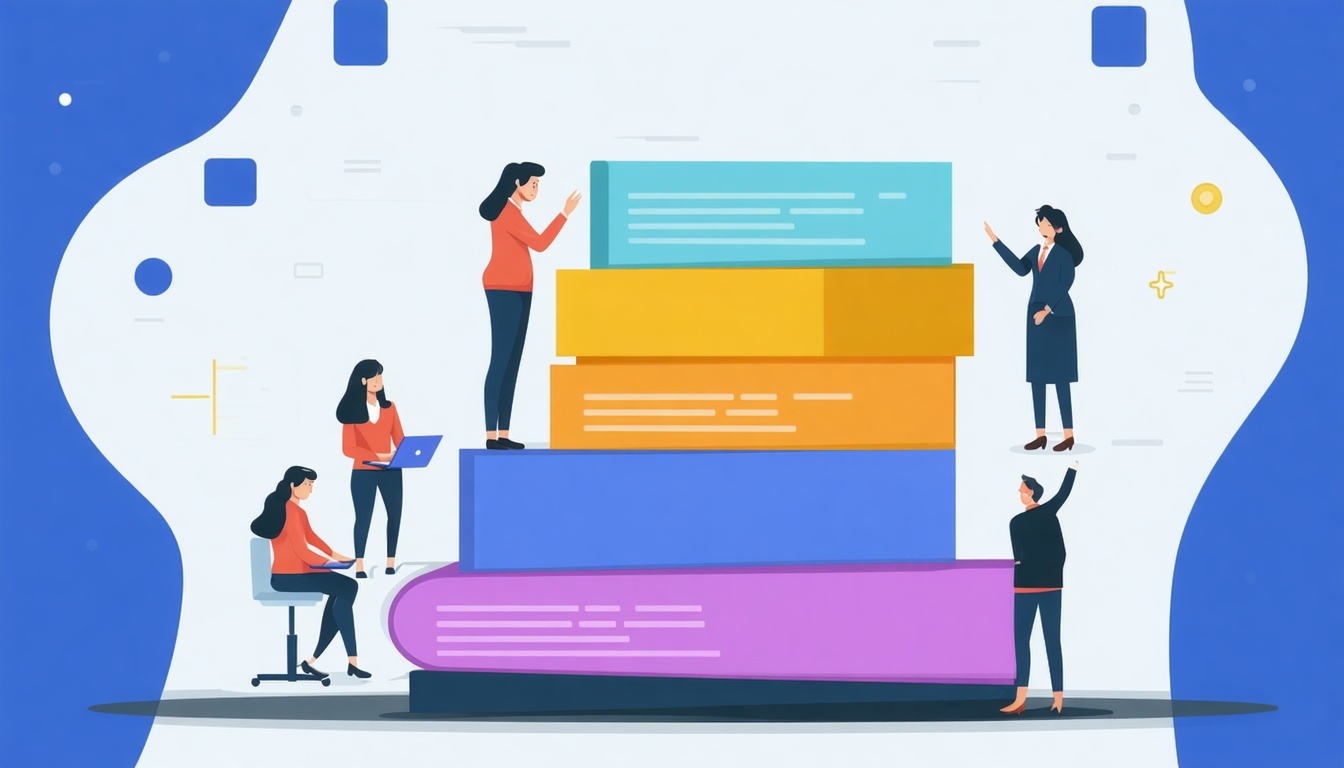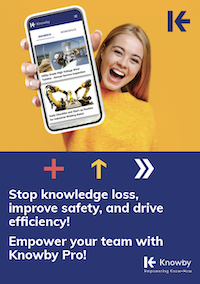Boost Knowledge Retention & Other Learning Retention Strategies

April 25, 2025

Knowledge retention is one of the biggest challenges facing learning and development teams today. No matter how strong your training program is, it won’t make a lasting impact unless employees can actually remember and apply what they’ve learned.
In this guide, we’ll explore what knowledge retention really means, why it breaks down after training, and how to improve learning retention in the workplace. You’ll also discover proven strategies—like microlearning, contextual access, and spaced repetition—and see how Knowby helps teams retain knowledge and perform at their best.
What is Knowledge Retention?
Knowledge retention is the process of ensuring that critical information stays with employees after training ends. In the workplace, this means that people can recall and apply what they've learned—whether it's how to complete a safety procedure, use a piece of equipment, or follow brand standards—without needing constant reminders.
Why is Knowledge Retention Important (and Why It Breaks Down After Training)?
Training is only as effective as what employees remember and use. Unfortunately, knowledge retention often breaks down due to:
- One-time training events: When training is delivered as a single event with no follow-up, the information is likely to fade within days. Learners might understand the material in the moment, but without opportunities to revisit and apply it, that knowledge quickly slips away. This approach often leads to wasted time and missed opportunities for long-term performance improvement.
- Lack of follow-up: Without regular check-ins or refresher content, learners don’t get the reinforcement needed to strengthen memory and build confidence. When no one revisits the material—through feedback, coaching, or reminders—it's easy for employees to forget what they’ve learned and fall back on guesswork or outdated habits.
- Information overload: Cramming too much information into a single session can overwhelm learners. When people are flooded with complex or unfamiliar content, their cognitive load increases, making it difficult to absorb or retain anything meaningful. In these situations, learners might walk away with a general idea—but not the detailed knowledge needed to take action on the job.
Example: A new hire completes onboarding and learns how to operate a machine. But two weeks later, when they need to perform a key step, they forget it—and there's no quick way to look it up. This can lead to mistakes, downtime, or even safety risks.
The Science Behind Learning Retention
The Ebbinghaus Forgetting Curve shows that people forget up to 70% of new information within 24 hours if there's no reinforcement. That’s not a failure of the learner—it’s just how human memory works.
How to Counter the Forgetting Curve
To boost learning retention and fight natural memory decline, your training strategies should embrace three essential principles:
1. Repeat and Refresh Over Time
The brain thrives on repetition. Reintroducing information at spaced intervals helps transfer it from short-term memory to long-term memory. This is where techniques like spaced repetition and micro-reminders come in—simple nudges that reinforce learning without overwhelming the learner. Think: periodic knowledge checks, short follow-up tasks, or quick video refreshers.
2. Deliver Information in Context
People remember better when they learn in the same environment where they’ll apply the knowledge. Training that’s tied to real-world scenarios—like step-by-step digital instructions shown right next to the equipment—helps the brain connect theory with action. Contextual learning builds relevance, which deepens memory retention.
A practical application of this is a ready-to-scan QR code that shows specific how-tos per equipment or process. Read the case study how Robotic Innovations implemented QR Code access to instructions on their FANUC CRX-25iA machine.
3. Make Knowledge Easy to Access
Memory isn’t always reliable—but access can be. When employees know where to find accurate, up-to-date information on the job, they don’t have to rely purely on recall. Digital tools that support “pull learning” empower learners to find exactly what they need, exactly when they need it. That means less time wasted searching, guessing, or repeating mistakes.
Cognitive load also plays a role. When training materials are dense or complicated, the human brain struggles to absorb and retain the information.
5 Strategies to Improve Knowledge Retention in the Workplace
Here are five research-backed strategies organisations can use to improve knowledge retention—not just during training, but well after the session ends.
1. Spaced Repetition
One-off training events might feel efficient, but they’re no match for how human memory works. Without reinforcement, most new knowledge fades quickly. Spaced repetition—where information is revisited over time—helps enhance knowledge retention by giving the brain multiple chances to absorb and recall content.
Tips:
- Schedule follow-ups or mini-refreshers days or weeks after the initial training.
- Use digital nudges—like mobile push notifications or short daily tips—to trigger recall at the right moment.
- Create small recap modules to reinforce key tasks or processes regularly.
The goal is not to repeat everything, but to strategically reinforce the most critical concepts when learners are likely to forget them.
2. Microlearning
Traditional teaching methods like long-form training sessions can overwhelm learners and lead to cognitive overload. Microlearning breaks complex topics into short, focused chunks—each one covering a single task, idea, or skill. This improves focus, boosts engagement, and supports better retention of information.
Ideal for:
- Mobile-first workplaces where learners are often on the move.
- "Just-in-time" environments where employees need instant answers on the job—such as retail, fieldwork, or frontline services.
- New hire onboarding, where introducing too much at once can be counterproductive.
Microlearning isn't just about making things shorter—it's about making them smarter and more actionable.
3. Active Recall & Practice
Passive learning—like watching a video or reading a slide deck—often creates a false sense of understanding. To build real retention, learners must be prompted to retrieve and use the information. Active recall strengthens neural pathways, and practice bridges the gap between knowing and doing.
Examples:
- Use quick quizzes to reinforce key concepts after each module.
- Encourage learners to practise tasks immediately after training—ideally in the environment where they’ll be performing the work.
- Create short feedback loops where learners can reflect on performance, receive input, and adjust.
Even small moments of hands-on application can dramatically improve memory retention and learner confidence.
4. Make It Visual and Interactive
People process visuals up to 60,000 times faster than text—and they remember it longer, too (thus the term “visual learners”). By considering the different learning styles and turning employee training into something interactive and visually rich doesn’t just make it more enjoyable—it makes it more memorable. This is especially valuable in workplaces where procedures or equipment use can’t be easily explained with text alone.
Tactics:
- Use how-to videos or GIFs to walk learners through complex steps.
- Incorporate annotated screenshots or step-by-step image guides.
- Try digital instruction manuals, which turns standard training materials into on-demand, task-based instructions that can be reused anytime.
When learners see and do, rather than just read or listen, information sticks longer and transfers more easily to real work.
"[With Knowby,] you can go through each step at your own pace without racing through it with all explanations in a video on how to do it. Makes life so much easier."
5. Contextual Access
Remember delivering information in context when it comes to fighting the forgetting curve? Retention isn’t just about memorising—it’s about knowing where to find information quickly when it matters. If employees don’t have a deeper understanding of processes or easy access to critical knowledge in the moment, they either rely on memory (which is unreliable) or make educated guesses (which can lead to errors). Contextual access means embedding knowledge where work happens.
Solution:
- Offer searchable, role-specific guides that are embedded into daily workflows.
- Replace passive documents or static LMS modules with interactive tools, allowing learners to pull up information on the job—via mobile or desktop.
- Use platforms like Knowby to ensure that instructions are always available, accurate, and easy to follow.
This approach not only improves retention of knowledge—it builds confidence, autonomy, and consistency in performance.
How Knowby Helps Teams Retain Critical Knowledge
Knowby makes it easier to capture, share, and retain knowledge—without relying on memory. By structuring complex processes into clear, step-by-step digital guides, Knowby empowers teams across functions to learn, reference, and update critical information seamlessly.
Digital Instructions
Inspired by traditional instruction manuals, Knowby’s digital instruction manual feature allows you to break down any process into digestible steps, enriched with loop videos, annotated images, and clear text prompts. Unlike static PDFs, these interactive guides help encourage employees to follow best practices precisely, reducing cognitive load and improving long-term recall.
Centralised Onboarding Workflows
Onboarding new team members is often time-consuming and knowledge-intensive. With Knowby, you can upload standard operating procedures (SOPs), training materials, and role-specific checklists into a single platform. Knowledge transfer is going to be easier for new hires as they receive structured learning paths with microlearning modules, instant feedback loops, and progress tracking. Teams using Knowby report a smoother onboarding experience and faster time-to-productivity—see our detailed employee onboarding process guide for best practices.
Streamlined IP Portfolio Management
Managing an IP portfolio requires meticulous documentation, version control, and compliance oversight. Knowby captures step-by-step workflows for patent filings, portfolio reviews, and renewal processes, turning complex legal procedures into accessible digital assets. Legal teams gain confidence knowing they can update guidelines instantly and share them with stakeholders, reducing risks and ensuring consistency.
Real-Time Content Updates
Procedures evolve as organisations innovate. Knowby’s platform allows administrators to edit or version digital guides in seconds—no more outdated binders or lost email attachments. Whenever a process changes, notifications are sent automatically to relevant users, ensuring everyone has the latest instructions at their fingertips.
Mobile-First, Just-in-Time Access
Whether on the shop floor, in the field, or at a customer site, employees can pull up knowledge on any device, even when offline. This just-in-time access prevents bottlenecks, reduces errors, and reinforces learning by providing support exactly when it’s needed most.
Benefits of Improved Knowledge Retention
Better retention doesn’t just help employees—it improves performance, consistency, and long-term outcomes across the board.
- Faster onboarding: Shortened time-to-productivity means new hires get up to speed more quickly, confidently performing tasks without constant supervision. This allows teams to scale efficiently and reduces the burden on trainers.
- Fewer errors: When knowledge is clearly documented and accessible, employees are more likely to apply it correctly. This leads to fewer mistakes on the job, which can boost safety, compliance, and customer satisfaction.
- Greater confidence: Employees who know how to do their job well not only gain a competitive advantage but also tend to feel more empowered and engaged. Confidence not only improves morale, it often leads to better decision-making and initiative on the floor.
- Less retraining: When people can access the right information on demand, there’s less need for repeat training sessions. This makes knowledge retention efforts more efficient and frees up time and resources for more strategic learning programs and development initiatives.
- Business continuity: When employees leave or change roles, they don’t take critical knowledge with them—because it’s already been captured and shared. Better knowledge retention ensures your existing processes, prior knowledge (of employees who left or got transferred), and best practices stay intact, no matter who’s on the team.
Improve Knowledge Retention with Knowby
Level up retention with tech-powered how-tos your team won’t forget 🎯
Steps to Boost Knowledge Retention in the Workplace
You can use Knowby to build a streamlined, retention-first learning process that’s simple to manage and highly effective for learners at every stage.
Step 1: Set Up Your Onboarding Plan
Upload SOPs, training materials, and role-specific guides to Knowby. By organising content into clear, task-based instructions, you create a foundation for repeatable learning. This step helps reduce cognitive overload from day one by focusing only on what each role needs to know. Learn how to optimise your onboarding process.
Step 2: Assign Training Modules
New hires receive structured learning paths with short, focused content that they can access on-demand. This approach on existing knowledge aligns with Knowby’s nanolearning methodology, ensuring each piece of information is delivered in manageable, bite-sized chunks that support better retention.
Step 3: Track Progress & Engagement
Managers can easily monitor each employee’s progress and identify gaps using the Knowby platform. This insight allows leaders to achieve learning objectives and spot where extra support is needed, offer timely interventions, and reinforce key concepts. It’s a more proactive way to support knowledge sharing and continuous improvement. Explore how effective knowledge sharing supports teams.
Step 4: Continuous Learning & Development
Use Knowby to deliver ongoing microlearning, refreshers, and new skills training programs to support long-term knowledge retention after employee training since onboarding. By incorporating learning into everyday workflows, employees can adapt to rapid technological advancements in the workplace as well as revisit key knowledge exactly when they need it—reinforcing memory and improving performance. This supports cognitive load reduction, giving learners a competitive advantage by keeping them focused and engaged without burnout.
Rethinking Knowledge Retention Strategies with Knowby
Relying on a one-time training session isn’t enough anymore. For better workplace knowledge retention, teams need:
- Continuous access to information.
- Training that’s engaging and digestible.
- Tools that support just-in-time learning.
- Knowledge repository that is safe and secure for the company.
Knowby empowers organisations to create a knowledge-first culture where learning sticks, performance improves, and teams feel confident.
Ready to improve knowledge retention in your workplace? Explore Knowby or book a demo to see it in action.

Comments